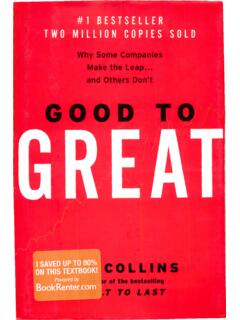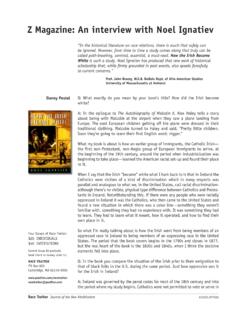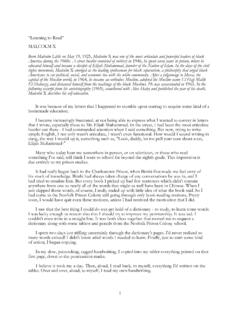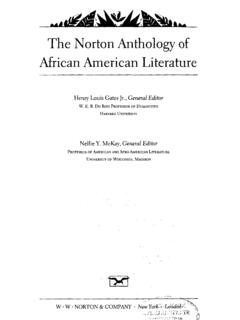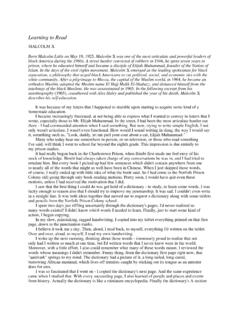Transcription of The Autobiography of Malcolm X - THE YOUNG TREPS
1 THE Autobiography OF Malcolm X with the assistance of Alex Haley Introduction by M. S. Handler Epilogue by Alex Haley Ballantine Books New York Sale of this book without a front cover may be unauthorized. If this book is coverless, it may have been reported to the publisher as "unsold or destroyed" and neither the author nor the publisher may have received payment for it. Copyright 1964 by Alex Haley and Malcolm X Copyright 1965 by Alex Haley and Betty Shabazz Introduction copyright 1965 by M. S. Handler All rights reserved under International and Pan-American Copyright Conventions. Published in the United States by Ballantine Books, a division of Random House, Inc.
2 , New York, and simultaneously in Canada by Random House of Canada Limited, Toronto. This edition published by arrangement with Grove Press, Inc. "On Malcolm X" by Ossie Davis previously appeared in Group magazine and is reprinted by permission. Library of Congress Catalog Card Number: 91-93124 ISBN: 0-345-37671-4 Cover design by Kristine V. Mills Cover painting by Charles Lilly Manufactured in the United States of America First Ballantine Books Edition: June 1973 First Ballantine Books Trade Edition: February 1992 This book I dedicate to my beloved wife Betty and to our children whose understanding and whose sacrifices made it possible for me to do my work.
3 CONTENTS Introduction ix 1 Nightmare 3 2 Mascot 28 3 "Homeboy" 47 4 Laura 66 5 Harlemite 82 6 Detroit Red 98 7 Hustler 125 8 Trapped 146 9 Caught 155 10 Satan 175 11 Saved 195 12 Savior 220 13 Minister Malcolm X 243 14 Black Muslims 271 15 Icarus 306 16 Out 332 17 Mecca 366 18 El-Hajj Malik El-Shabazz 394 19 1965 419 Alex Haley: Epilogue 441 Ossie Davis: On Malcolm X 524 M. S. HANDLER INTRODUCTION The Sunday before he was to officially announce his rupture with Elijah Muhammad, Malcolm X came to my home to dis cuss his plans and give me some necessary documentation. Mrs. Handler had never met Malcolm before this fateful visit.
4 She served us coffee and cakes while Malcolm spoke in the courteous, gentle manner that was his in private. It was obvious to me that Mrs. Handler was impressed by Malcolm . His per sonality filled our living room. Malcolm 's attitude was that of a man who had reached a crossroads in his life and was making a choice under an inner compulsion. A wistful smile illuminated his countenance from time to time-a smile that said many things. I felt uneasy be cause Malcolm was evidently trying to say something which his pride and dignity prevented him from expressing. I sensed that Malcolm was not confident he would succeed in escaping from the shadowy world which had held him in thrall.
5 Mrs. Handler was quiet and thoughtful after Malcolm 's de parture. Looking up suddenly, she said: "You know, it was like having tea with a black panther." The description startled me. The black panther is an aristo crat in the animal kingdom. He is beautiful. He is dangerous. As a man, Malcolm X had the physical bearing and the inner self-confidence of a born aristocrat. And he was potentially dan gerous. No man in our time aroused fear and hatred in the white man as did Malcolm , because in him the white man sensed an implacable foe who could not be had fo r any price-a man un reservedly committed to the cause of liberating the black man ix X THE Autobiography OF Malcolm X in American society rather than integrating the black man into that society.
6 My first meeting with Malcolm X took place in March 1963 in the Muslim restaurant of Te mple Number Seven on Lenox Avenue. I had been assigned by Th e New Yo rk Times to inves tigate the growing pressures within the Negro community. Thirty years of experience as a reporter in Western and Eastern Europe had taught me that the fo rces in a developing social struggle are frequently buried beneath the visible surface and make them selves felt in many ways long before they burst out into the open. These generative fo rces make themselves felt through the power of an idea long before their organizational fo rms can openly challenge the establishment.
7 It is the merit of European political scientists and sociologists to give a high priority to the power of ideas in a social struggle. In the United States, it is our weakness to confuse the numerical strength of an organi zation and the publicity attached to leaders with the germinating forces that sow the seeds of social upheaval in our community. In studying the growing pressures within the Negro com munity, I had not only to seek the opinions of the established leaders of the civil rights organizations but the opinions of those working in the penumbra of the movement-"underground," so to speak.
8 This is why I sought out Malcolm X, whose ideas had reached me through the medium of Negro integrationists. Their thinking was already reflecting a high degree of nascent Negro nationalism. I did not know what to expect as I waited for Malcolm . I was the only white person in the restaurant, an immaculate estab lishment tended by somber, handsome, uncommunicative Ne groes. Signs reading "Smoking Forbidden" were pasted on the highly polished mirrors. I was served coffee but became uneasy in this aseptic, silent atmosphere as time passed. Malcolm fi nally arrived. He was very tall, handsome, of impressive bear ing.
9 His skin had a bronze hue. I rose to greet him and extended my hand. Malcolm 's hand came up slowly. I had the impression it was difficult for him to INTRODUCTION Xi take my hand, but, noblesse oblige, he did. Malcolm then did a curious thing which he always repeated whenever we met in public in a restaurant in New Yo rk or Washington. He asked whether I would mind if he took a seat facing the door. I had had similar requests put to me in Eastern European capitals. Malcolm was on the alert, he wished to see every person who entered the restaurant. I quickly realized that Malcolm con stantly walked in danger.
10 We spoke fo r more than three hours at this first encounter. His views about the white man were devastating, but at no time did he transgress against my own personality and make me feel that I, as an individual, shared in the guilt. He attributed the degradation of the Negro people to the white man. He de nounced integration as a fraud. He contended that if the leaders of the established civil rights organizations persisted, the social struggle would end in bloodshed because he was certain the white man would never concede fu ll integration. He argued the Muslim case fo r separation as the only solution in which the Negro could achieve his own identity, develop his own culture, and lay the foundations fo r a self-respecting productive com munity.
